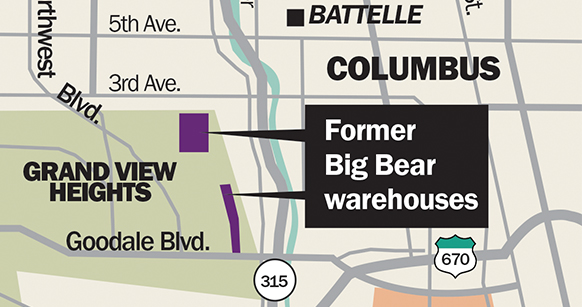
Plan would transform old Big Bear property
December 20th, 2007
Martin Rozenman, THE COLUMBUS DISPATCH
The old Big Bear property on Grandview Heights’ eastern edge is slated for a 10-year, $650 million makeover.
The result, says developer Nationwide Realty Investors, will be Grandview Yard. It’s slated to be home to national and regional retailers, offices, 5,000 jobs, 800 to 1,200 new Grandview residents and $5 million in new tax income. Those taxes would double Grandview’s current take, city officials said.
Work could begin in mid-2009 with possible completion of a first phase in 2010, said Brian Ellis, Nationwide Realty president.
Nationwide Realty also developed the Arena District, the 75-acre development surrounding Nationwide Arena that includes office space, restaurants and entertainment venues, as well as residential units. Investment in that project is now about $700 million, Ellis said.
“(Grandview Yard) will have significant similarities to the Arena District” without the sports element, Ellis told members of the Columbus Metropolitan Club at their meeting at the Columbus Athletic Club yesterday afternoon. Grandview Yard is just the sort of multiuse development that Grandview officials want to see on the site, bordered by 3rd Avenue, the CSX railroad tracks, Goodale Boulevard and an alley near Northwest Boulevard.
Nationwide Realty currently owns about 70 acres in that area, said Patrik Bowman, Grandview’s development director.
Grandview officials have targeted the area since their 1997 plan named it the Grandview Commerce District. Plans became more pressing in 2004 after Big Bear’s parent company, Penn Traffic, declared bankruptcy. That emptied more than 1 million square feet of warehouse space there.
The development plan will be approved in increments by City Council, with the first portions to be voted on in January.
Last night at Edison Intermediate Middle School, Ellis told the Grandview planning commission and about 200 residents and city employees that the project could contribute tenfold what Big Bear contributed in jobs and taxes at its peak. He said Big Bear at one time employed 500 people and paid $500,000 in taxes a year.
The area will be “very densely developed,” Ellis said, and include up to 2 million square feet of commercial space.

